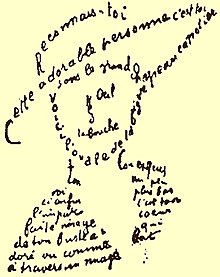Calligram

A calligram is a set of words arranged in such a way that it forms a thematically related image. It can be a poem, a phrase, a portion of
scripture, or a single word; the visual arrangement can rely on certain use of the typeface, calligraphy or handwriting
, for instance along non-parallel and curved text lines, or in shaped paragraphs. The image created by the words illustrates the text by expressing visually what it says, or something closely associated; it can also, on purpose, show something contradictory with the text or otherwise be misleading, or can contribute additional thoughts and meanings to the text.
Writers
Guillaume Apollinaire was a famous calligram writer and author of a book of poems called Calligrammes.
José Juan Tablada wrote a book of Spanish-language calligrams entitled Li-Po y otros poemas[1].
Gallery
-
Calligram of a tiger in Arabic script
-
Calligram of a snake inGeorgian script
-
Calligram about the Eiffel Tower by Guillaume Apollinaire
-
Biggest calligram in the world, part of the permanent exhibition of the Valencian Museum of Ethnology.
-
In 1834 a French court ordered the satiric newspaper Le Charivari to publish on its front page a judgement entered against it for having carried a drawing of King Louis-Philippe in the shape of a pear. The newspaper printed the document as instructed—but in the shape of a pear.
See also
References
Citations
- ^ "Li-Po y otros poemas". www.tablada.unam.mx. Retrieved 13 December 2022.
Sources
- Deme, Zoltan (1995). "Poem-miniatures". Chords of Scales: Selected Fictions, Essays, and Studies. Warwick Township, N.Y: Universe Pub. LCCN 2003278749.
- Kajima, Shōzō (1972). Post-War Japanese Poetry. Harmondsworth: Penguin Books. OCLC 622904. (with many Japanese calligrams)
- Neef, Sonja A.J. (2000). Kalligramme: Zur Medialität Einer Schrift : Anhand Von Paul Van Ostaijens De Feesten Van Angst En Pijn (in German). Amsterdam: ASCA Press. ISBN 90-76123-04-7.





